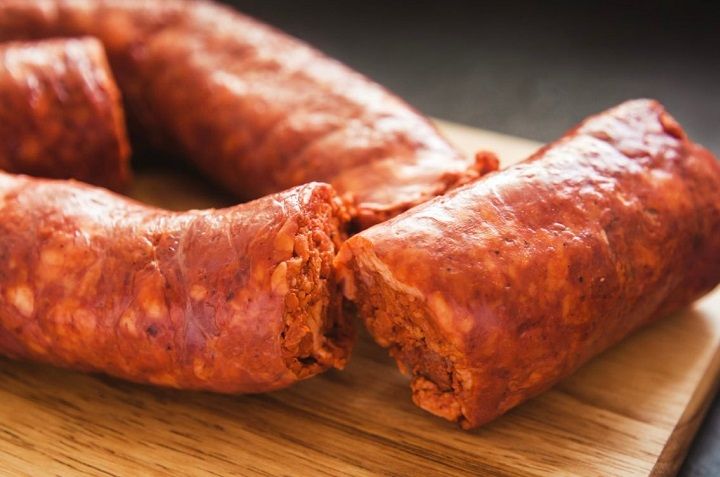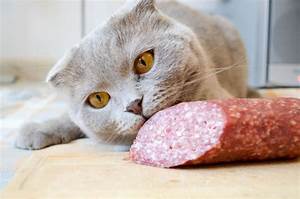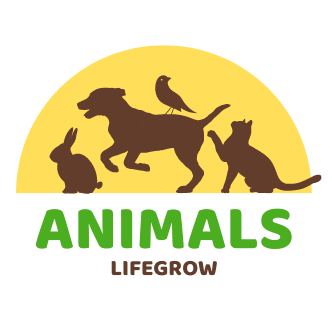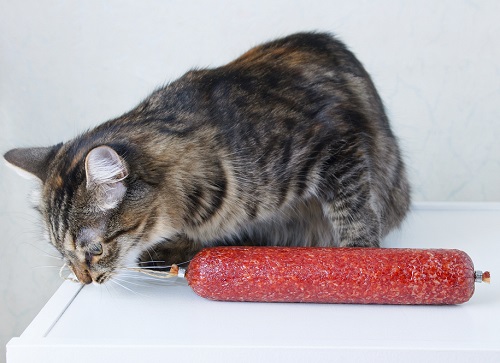Can You Feed Your Cat Chorizo? Understanding the Best Health Risks
Can Cats Eat Chorizo? A Comprehensive Guide to Feline Nutrition
If you’re a cat owner and love cooking or experimenting with different types of food, you may have wondered whether it’s safe to share some of your meals with your feline friend. One dish that might come to mind is chorizo, a flavorful sausage popular in many cuisines. But before you give your cat a small bite of chorizo, it’s important to understand the potential risks and benefits. In this blog, we’ll explore whether cats can eat chorizo and what you need to know about feeding it to your pet.
What is Chorizo?
Chorizo is a type of sausage made from ground pork (or beef), seasoned with various spices, including paprika, garlic, and other herbs. It comes in different varieties, such as Spanish chorizo, which is typically cured and smoked, and Mexican chorizo, which is often raw and must be cooked before eating.

The strong flavors, rich fats, and spices that give chorizo its distinct taste can be quite appealing to humans, but when it comes to cats, the situation is a little different.
Can Cats Eat Chorizo?
While cats are obligate carnivores, meaning they need meat to survive, feeding them human foods like chorizo is not recommended. Although cats can technically eat small amounts of chorizo, it doesn’t mean that it’s safe or healthy for them. Let’s break down why:
1. High Fat Content
Chorizo is typically high in fat. While some fat in your cat’s diet is necessary, an excessive amount can lead to health issues such as obesity, pancreatitis, and digestive problems. Cats that are fed too much fatty food may experience an upset stomach, diarrhea, or even more serious long-term conditions.
2. Spices and Seasonings
The strong spices and seasonings in it, including garlic and onion, can be toxic to cats. Even small amounts of garlic and onion can cause gastrointestinal upset, lethargy, and, in severe cases, damage to red blood cells, leading to anemia. Since chorizo is often heavily seasoned, it’s best to avoid feeding it to your cat altogether.
3. High Sodium Content
Chorizo is also high in sodium. Too much salt can lead to dehydration, kidney damage, or even salt poisoning in cats. Symptoms of salt poisoning can include vomiting, diarrhea, excessive thirst, and tremors. Cats with pre-existing kidney conditions are especially vulnerable to the harmful effects of too much salt.
4. Processed Meat Risks
Chorizo is a processed meat, and processed foods often contain preservatives, additives, and artificial flavors that are not suitable for cats. These chemicals could potentially cause digestive issues or other health concerns in your pet. Cats are not designed to handle processed foods the same way humans can.
5. Risk of Choking
If you decide to give your cat a small piece of chorizo, there’s also the risk of choking, especially if it’s cut into small, uneven pieces. The sausage’s firm texture may not be easy for your cat to chew properly, which could lead to a choking hazard or gastrointestinal blockages.
6. Obesity Risk
Chorizo’s rich combination of fat, protein, and salt can make it very tempting for cats to overeat, leading to excessive calorie intake. If your cat is regularly given high-calorie human food like chorizo, they may gain weight quickly, which increases the risk of obesity-related health problems such as diabetes, joint issues, and heart disease.
What Should You Feed Your Cat Instead?
Instead of chorizo, it’s important to stick to a diet that’s specifically designed for cats. High-quality cat food provides the right balance of protein, fats, vitamins, and minerals that your cat needs to stay healthy. You can offer your cat lean, cooked meats like chicken, turkey, or beef in moderation, but make sure they are free from seasoning, salt, or harmful ingredients.
If you want to spoil your cat with a special treat, there are many commercially available cat treats made specifically for feline diets. You can also try offering fresh, plain meat (without any spices) or a small portion of cooked fish. Always be mindful of portion sizes and never overfeed your cat with treats or human food.
What Should You Do if Your Cat Eats Chorizo?
If your cat has accidentally eaten a small piece of chorizo, don’t panic. While one small bite might not cause significant harm, keep an eye on them for any signs of discomfort or illness, such as vomiting, diarrhea, lethargy, or unusual behavior.

If you notice any concerning symptoms or if they consume a large amount of chorizo, it’s best to contact your veterinarian right away. They can offer advice and determine if any treatment is necessary.
Facts About Chorizo and Feeding Cats
| Fact | Details |
|---|---|
| Chorizo Composition | Spanish Chorizo: Ground pork, salt, curing salt, paprika, garlic, various seasonings/spices. – Mexican Chorizo: Pork (or beef), pork fat, chile peppers, vinegar, garlic, salt, various seasonings/spices. Ingredients may vary by region and recipe. |
| Harmful Ingredients for Cats | Salt: Can cause salt poisoning, symptoms include decreased appetite, loss of balance, increased urination and thirst, diarrhea, lethargy, tremors, seizures, coma. – Garlic: Highly toxic, leads to oxidative damage to red blood cells causing anemia, symptoms include lethargy, pale gums, weakness, rapid breathing, increased heart rate, collapse, diarrhea, vomiting, drooling, nausea, stomach pain, mouth irritation. – Onions: Toxic, similar symptoms to garlic poisoning. – Spices: Can cause stomach upset, symptoms include vomiting, diarrhea, nausea, gastrointestinal irritation. – Fat: Excessive consumption can lead to diabetes, pancreatitis, obesity. |
| Cat’s Dietary Needs | Obligate carnivores, require at least 70% animal-based nutrition. – Reduced ability to digest plant matter. – Commercial cat food provides balanced nutrition. – Small treats okay occasionally. |
| Safety Measures for Feeding Cats | Avoid feeding human foods like chorizo. – Cook meats thoroughly to eliminate pathogens. – Avoid feeding foods cooked in oil. – Skip feeding raw meats from grocery stores. – Heat processing and cooking meats at home can sterilize effectively. |
| Alternative Options | Feed cats uncured ground meats or meat cuts. – Consider whisker-friendly bowls. |
| Final Considerations | Chorizo not suitable for cats. – Other safe options available for occasional treats made from suitable ingredients. |
The Dangers of Sharing Human Food with Cats
While it may seem harmless to share a small bite of your meal with your cat, it’s important to recognize that not all human foods are suitable for them. Some foods, even in small amounts, can cause severe health problems. In addition to chorizo, other common foods that should be avoided include:
- Chocolate: Toxic to cats and can cause vomiting, diarrhea, and even seizures.
- Grapes and raisins: These can lead to kidney failure in some cats.
- Onions and garlic: Both are harmful to cats, leading to anemia and gastrointestinal problems.
- Dairy products: Many cats are lactose intolerant and consuming dairy can lead to upset stomachs.
It’s always best to avoid giving your cat foods that are not specifically designed for them. Instead, focus on providing a balanced diet with safe and healthy treats.
Conclusion
In summary, while cats can technically eat chorizo in very small quantities, it’s not advisable to feed it to them regularly or in large amounts. The high fat content, spices, sodium, and potential toxins make chorizo a risky food for your feline friend. Always prioritize your cat’s health by offering them nutritionally balanced food that’s designed for their specific dietary needs.
If you’re ever in doubt about what’s safe to feed your cat, it’s always a good idea to consult with your veterinarian. They can help guide you in making the best dietary choices for your pet, ensuring they live a long and healthy life.
And also read : Cats: The Beloved and Beneficial Pet
FAQ’s
Q1: Can cats eat chorizo safely?
While cats can technically eat small amounts of chorizo, it is not recommended due to its high fat, salt, and spice content, which can be harmful to their health.
Q2: What ingredients in chorizo are harmful to cats?
Chorizo often contains garlic and onion, both of which are toxic to cats. Additionally, the high levels of sodium and fat can lead to gastrointestinal issues or more serious health problems.
Q3: What symptoms might indicate my cat has eaten chorizo?
Signs of distress may include vomiting, diarrhea, lethargy, or excessive thirst. If you notice any of these symptoms, consult a veterinarian immediately.
Q4: Can occasional tiny bites of chorizo hurt my cat?
Occasional tiny bites may not cause immediate harm, but it’s best to avoid giving your cat chorizo altogether to prevent potential health issues in the long run.
Q5: How does feeding chorizo affect a cat’s diet?
Feeding your cat chorizo can disrupt their balanced diet, leading to obesity, pancreatitis, or other serious health issues due to its high fat and sodium content.

